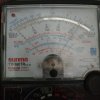bikingbuddha
Well-Known Member
Greetings everyone... 
This morning I was told a very disturbing story by my electronically inclined friend. In fact, it became worrisome to me so I decided that I shouldn't just take his word, I should ask the experts in AK .
.
Both my primary amplifiers are running on 230V to 110V step-down transformers. Both are Japanese made in the '70s which clearly states that 100V in the back.
Technics SA-7700ii (100V)
Victor JA-31 (100V)
So far I never had a problem of heating up or anything even though I run them all day long. But my friend told me that they need100V stepdown transformers instead of 110V. Otherwise, it will fry the circuits inside and cook them...! most of the amplifiers he gets for repair are totally roasted because of prolonged usage connected to 110V stepdown instead of 100V. It totally freaks me out because I don't want to destroy them.
Does this really effects...? I mean, as far as I know, they are built to run in between 80Volts to 120V (max) even though it says 100V there.
So far I don't have any issues but should I be concerned about this...? I don't think I can find 230V to 100V step-down converters anywhere in my country because everyone calls this Japanese 110V stuff...! but they are really 100V. If I need a clear 100V I need to get a custom-built transformer to do the job which is going to cost a lot. (in where I live, Definitely not a great place for an audiocholic).
Am I good with my current system or should I be concerned...?
Thanks a lot, AK Folks,
This morning I was told a very disturbing story by my electronically inclined friend. In fact, it became worrisome to me so I decided that I shouldn't just take his word, I should ask the experts in AK
Both my primary amplifiers are running on 230V to 110V step-down transformers. Both are Japanese made in the '70s which clearly states that 100V in the back.
Technics SA-7700ii (100V)
Victor JA-31 (100V)
So far I never had a problem of heating up or anything even though I run them all day long. But my friend told me that they need100V stepdown transformers instead of 110V. Otherwise, it will fry the circuits inside and cook them...! most of the amplifiers he gets for repair are totally roasted because of prolonged usage connected to 110V stepdown instead of 100V. It totally freaks me out because I don't want to destroy them.
Does this really effects...? I mean, as far as I know, they are built to run in between 80Volts to 120V (max) even though it says 100V there.
So far I don't have any issues but should I be concerned about this...? I don't think I can find 230V to 100V step-down converters anywhere in my country because everyone calls this Japanese 110V stuff...! but they are really 100V. If I need a clear 100V I need to get a custom-built transformer to do the job which is going to cost a lot. (in where I live, Definitely not a great place for an audiocholic).
Am I good with my current system or should I be concerned...?
Thanks a lot, AK Folks,



